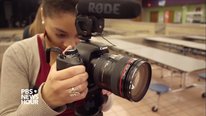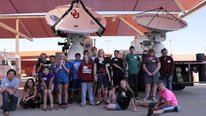- Andrew Izsak
- Professor
- Investigating Proportional Reasoning from Two Perspectives
- http://temrrg.wix.com/temrrg
- University of Georgia
- Sybilla Beckmann
- https://faculty.franklin.uga.edu/sybilla/
- Meigs Distinguished Teaching Professor of Mathematics
- Investigating Proportional Reasoning from Two Perspectives
- http://temrrg.wix.com/temrrg
- University of Georgia
Public Discussion
Continue the discussion of this presentation on the Multiplex. Go to Multiplex








Andrew Izsak
Professor
Welcome to our video. Last year we posted a video working through a proportional relationship problem to give a taste of our approach to topics related to multiplication. This year, we focus on the engagement of future middle grades teachers in our content courses. They are learning core middle grades mathematics in ways useful for teaching.
Wendy Smith
Associate Director
Can you say a little more about the context of your project? How many mathematics courses do future middle grades teachers have to take? How much have the teachers in the video done before you can get them to this (great!) point of being able to reason about fraction operations like this? How long does it take with the future teachers in the first math course to convince them there is more they need to know about fractions (and other math topics) that they will need for teaching students?
Andrew Izsak
Professor
Hi Wendy,
Thank you for your interest!
We are running the project with future mathematics teachers in two programs, middle grades (Grades 4-8) and secondary grades (Grades 6-12). In the middle grades program, future teachers take a standard first calculus course and 2 mathematics for teachers courses. One on number and operation and one on algebra. The video clip we included is from early in the algebra course (so think second semester). Most of the number and operations course focuses on the meaning of multiplication with whole numbers shown in the clip, properties like commutativity, and how to think about multiplication in consistent was across whole numbers and fractions. Students also study both types of division with whole numbers in the first course. At the beginning of the second course they extend the study of division from whole numbers to fractions.
Future teachers in the secondary program, not shown in the video, complete most of a math major including a course in abstract algebra. They need a whole semester to go from whole number multiplication and division, to fraction multiplication and division, to proportional relationships and linear equations. We suspect that most secondary preparation programs do not devote adequate time to building this foundational content in a coherent way.
Sybilla teaches the future middle grades teachers and I teach the future secondary teachers. I do not find much resistance from future secondary teachers. I open the course reminding my students that are being prepared to teach grades 6-12 and so are responsible for the content. I also tell them about an experience I had several years tutoring a 10th student who was having trouble with geometry homework not because he did not understand the geometry content, but because he did not understand fractions and division. Then I ask students to give word problems that illustrate fraction division. They find this hard, and I have convinced them that the course is important.
Miriam Sherin
Professor, Associate Dean of Teacher Education
Your focus on multiplication as measurement is clearly important - helping future teachers explore mathematics deeply is critical if we want them to be able to support meaningful learning on the part of their students. I'm wondering how your approach changed, if at all, from working with students' understandings of these ideas to supporting future teachers. Is there an explicit pedagogical component to their work as well?
Andrew Izsak
Professor
Hi Miriam,
Thank you for the question. The courses in which we work are content courses. The preparation programs also include separate methods courses (we refer to them as pedagogy courses). As such, we do not focus as much in the courses on how students think, though students' ideas do come up. I would say the most prevalent and explicit pedagogical component is being able to give clear explanations for solutions to problems that make use of drawn models, especially double number lines and strip diagrams, to show quantities. The video clip includes one nice example of this. Future teachers are learning how to use such models to support their own thinking and as a resource for explaining their thinking to others. Most future teachers who come to our courses have only been taught rules for calculating with numbers. Reasoning with drawings is new for them.
Miriam Sherin
Professor, Associate Dean of Teacher Education
Thanks! this is really interesting work!
Kevin Brown
I also am interested in the extent to which your approach to teacher professional development is grounded in research on how students learn mathematics? Or relatedly, do you plan to study the impact on student learning comparing teachers trained in your method vs. standard teaching methods?
Andrew Izsak
Professor
Hi Kevin,
Thank you for the questions. I will answer them in reverse. For the current project, we are not trying to connect teachers' preparation to student learning. That is down the road. Next fall we will be conducting a study comparing future teachers at UGA and at a second institution in Georgia that also prepares teachers, but not using our multiplication-as-measurement approach. A main measure we will be using the DTMR Fractions survey, developed as part of an earlier NSF project. That survey measures components of reasoning needed to solve fraction arithmetic problems in terms of measured quantities.
As for your second question, we are simply trying to understand how our measurement perspective can help future teachers begin to construct a coherent view of topics related to multiplication. Our ideal goal is for them to understand that whole number multiplication, arithmetic with fractions, proportional relationships, and linear equations are all tied together by an analysis of units and groups of units. Further topics related to geometric similarity and statistics can also be integrated.
The main learning theory we draw from is diSessa's knowledge-in-pieces (KiP) that emphasizes incremental coordination and refinement of diverse knowledge elements. In our case those elements include things like prior associations with terms like "multiply" and "division," meanings for the equal sign, etc. At the moment, it looks likes aspects of coordination class theory (a subset of KiP) will be useful for gaining insight especially into the interview data we are collecting as part of the project. The conjecture is that in order for future teachers to develop a coherent view of multiplication as measurement, they need to develop ways to perceive the multiplicand, multiplier, and product amount in diverse settings. This maybe akin to developing different concept projections and more elaborate chains of inference for establishing the equal-sized groups structure. Other learning theories, such as Steffe and colleagues' radical constructivist accounts of how children learn fractions have some ideas useful for us, but we have not yet found theoretical constructs like schemes to be particularly helpful in understanding the moment-to-moment reasoning we observe.
Jeremy Roschelle
Andrew and Sybilla,
Great foundational work!
What do you imagine as a theory of change that leads from this insight and approach to the kinds of things that show up as meaningful to district leaders or state policymakers? Does the approach get embedded into curricula, or is this just a matter of PD? Would you want assessments to change so you could detect / diagnosis ? Is this mostly a matter of pre-service or... well you get the idea. If someone asked you to use your insight to transform a state, how would you do it?
thanks!
jeremy
Andrew Izsak
Professor
Hi Jeremy,
Thank you for the questions about the long-term trajectory of our work beyond the current project. I have answers for two of them.
With respect to curricula, in the short term, Sybilla is taking lessons from our research and incorporating them into her math for elementary teachers textbook, now in its 5th edition. We also think that a main implication of our approach for curricula is that teaching topics like fraction division in isolation is less likely to be successful than an approach like ours which attempts to address coherence across many topics in the multiplicative conceptual field. Ultimately, we would like curricula both for future teacher and for students to exhibit such coherence.
We are interested in assessment. For the current project, we are investigating the sensitivity of the DTMR Fractions survey to detect pre-post shifts in profiles. There are pieces about this survey in EM:IP and the recently published JRME monongraph on psychometrics and mathematics education. The survey is based on diagnostic classification models, not IRT. One of the things that might come out of our project is refined ideas about core components of reasoning to assess, how to assess them (e.g., item design), and what kinds of psychometric models might be good matches.
Finally, with respect to district leaders, we do have as part of our dissemination plans to present to a conference of GA superintendents. We are interested in learning about what resonates with them.
Further posting is closed as the showcase has ended.